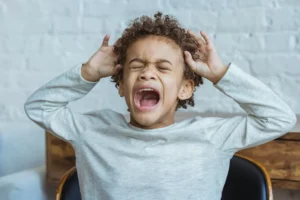Anxiety can manifest in a child for several reasons. It can be related to school, family or even just understanding themselves. It can be harder for a child to express themselves as they may not understand what they are feeling if it is the first time that they are experiencing an emotion. Trying to understand why your child is anxious can be difficult. Children are very responsive to how their parents react, so it is important that when they are talking about how they are feeling that they are encouraged to speak. As children are still growing and understanding their world, they are still under the responsibility and care of their parents, and so when they begin to experience anxiety it is something of their own which is why it can become overwhelming for them to understand why it is happening. Usually, a child can overcome these anxious feelings and thoughts themselves however in some cases they may become fixed on a thought pattern or emotional response which can make it difficult for them to resolve.

Parent’s may not know what to say to a child with anxiety if they have not experienced it themselves. This may lead to you reaching out to work with a therapist to help your child navigate their anxious feelings. This helps provide your child with healthy coping skills and can also allow you to work with your child to understand what is triggering their anxiety psychologically and socially. If your child learns these skills early on in life it can help them with their relationship towards their anxiety later on. While we can never fully ‘cure’ anxiety we can learn how to adapt it and use the response in another way.
Common Triggers of Child Anxiety
It can be difficult to understand what causes anxiety in a young child. As a parent you try to make their environment as safe and understanding as is possible. However, you cannot always predict how they will react to a situation. Different anxiety conditions can arise such as separation anxiety. In this scenario, your child may find it difficult to be away from their parents for extended periods of time which can impact how they navigate life outside of the home. They may also experience social anxiety, where they can worry about how to behave around other people and meeting the expectations of adults. Children may not feel comfortable being around people they do not know; it can be an overwhelming experience for them to try and make social connections in an unfamiliar situation. Phobias are also another common display of anxiety in children. Children may attach feelings of worry and fear onto something which can be difficult for them to overcome.
Children’s anxiety can also attach itself to different environments such as school, family life or social interactions. These can be common triggers that a child may project their anxiety onto to try and make sense of what they are feeling. If a child feels worried about going into school, they may put the blame on attending school, but this could actually be symptoms of social anxiety. If the child does not recognise this for themselves, it can also be difficult for parents to see this in them too.
Identifying Triggers in Your Child
Knowing what triggers anxiety in a child can help with supporting a child with anxiety. If you are aware of your child’s anxious reactions, you can work with them in a way that can help calm them down while also being aware of what they are feeling. Some children can experience physical anxiety symptoms such as an upset tummy, appearing nervous and having disruptions in their eating patterns. These physical symptoms may be easy to overlook but if they are not addressed, they can become a recurring problem for a child as they grow. Speaking with your child when they feel uneasy can help them begin to identify their anxiety and recognise that they have a space to speak about their feelings.
How to Help a Child with Anxiety
There are many guides about how to help your child overcome anxiety There are different techniques that you as a parent can help them with. If your child recognises that they have a safe space where they can talk within their family they may be more likely to express themselves openly later in life as they understand their family as a support. Using mindfulness meditation as a calming technique can also be a lifelong skill for helping manage anxiety. By using breathwork this helps to stop them ruminating over any anxious thoughts that are preoccupying their mind. It helps to centre the child in the present moment and relieves them of the worry that they may have about their external world. Another technique which may be beneficial is gradually exposing your child to a thing that can provoke an anxious response in them, for example if your child has developed a fear of dogs you could bring them to a dog park which allows them to be near dogs but not have to directly interact with them. By bringing the child into the anxious situation but allowing them to have a controlled response this will hopefully allow them to realise that an anxious feeling will not always happen in the real world.
In some cases it can be difficult to help your child break away from their anxiety. You may need to look for professional help by way of a child play therapist. This therapy approach helps provide a safe space for the child to express themselves without just having to speak. It allows the child to tap into their creativity and channel their emotions into play as a way to work through any difficulties. Cognitive Behavioural Therapy for child anxiety is also another effective treatment, it can help the child to break away from their anxious thought patterns and allow them a freer way of being.
Anxiety is something that we will all experience. If it happens early in life it can build negative behavioural responses within us that can have a consequences for us as adults. However, recognising anxiety within your child and building coping skills to help them manage can be beneficial not only to them but to the overall family dynamics.

